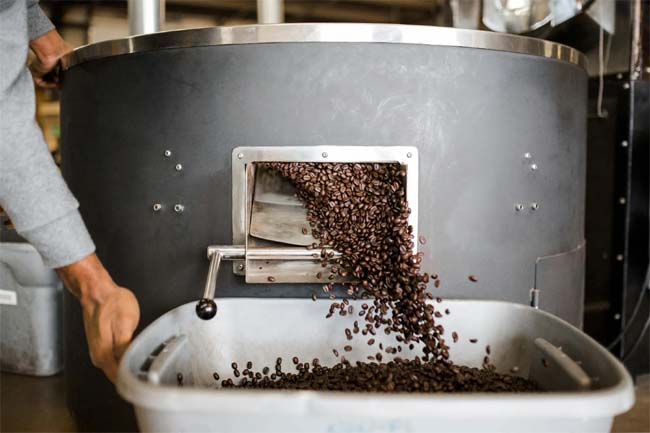COFFEE - A VITAL STAPLE
For countless individuals around the globe, coffee has become an essential part of daily life. Whether it's fueling the morning routine, enjoying a chat with a friend, or pushing through a study marathon, coffee plays a significant role. What is it about this beloved drink that makes a 'cup of joe' such a vital staple for so many?
DIFFERENT BREWING METHODS
Perhaps it is the variety of different coffee brewing methods, ranging from the timeless drip coffee and popular cold brew to the meticulous French press and the bold flavor of espresso. The main distinction among these methods lies in the interaction between water and the coffee grounds, as well as the duration of the brewing.
Drip Coffee-Hot water slowly passes through ground coffee beans.
Pour-Over-Steps up the drip method by offering better control over the brewing process.
French Press-Steeps the grounds in hot water before pressing them through a filter.
Espresso Machine- Forces water through finely ground beans at high pressure, creating a concentrated shot.
Cold Brew-Steeps grounds in cold water for an extended period, resulting in a smooth, low-acid brew.
Instant Coffee-The quickest and easiest brewing method in which roasted coffee is dried into a powder or crystals. Pouring hot water over the powders produces a ready-to-drink cup of coffee.
THE CHEMISTRY BEHIND COFFEE &
THE CHEMICAL ACRYLAMIDE
Since over 67% of American adults drink some type of coffee every day (more than any other beverage, including tap or bottled water), could there be any health concerns with the chemistry behind this American love affair with coffee? One chemical compound that can be found in coffee is the potentially controversial acrylamide.
Acrylamide is a chemical compound that mainly forms during the Maillard reaction, which is the interaction between amino acids and reducing sugars when food is cooked at temperatures exceeding 248 degrees Fahrenheit.
This reaction enhances the color and taste of various foods and can be found in a variety of items, including baked goods, fried foods, and coffee.
Some animal studies have indicated that high levels of acrylamide can lead to cancer, but it is crucial to recognize that data derived from toxicology studies in rodents may not translate perfectly to humans. So far, research involving humans has not established a clear link between dietary acrylamide exposure and the development of various cancers.
SHOULD WE CONCERNED ABOUT THE PRESENCE OF ACRYLAMIDE IN OUR COFFEE?
Should we be concerned about acrylamide in our coffee?
Various health organizations estimate the acceptable daily intake of acrylamide for humans to range between 25 and 195 micrograms, though these figures are largely based on educated guesses.
A typical cup of brewed coffee (other than instant) contains around .45 micrograms of acrylamide, a negligible amount. Lighter roasts are generally subjected to lower temperatures and shorter roasting times compared to darker roasts, resulting in lower acrylamide levels.
Instant coffee can contain as much as twice the amount of acrylamide than can be found in regularly brewed coffee. So how much instant coffee would an individual have to consume for acrylamide to become a concern?
Instant coffee has approximately 10 micrograms of acrylamide per quart. To hit the lower threshold of the recommended daily acrylamide exposure, which is about 25 micrograms, one would need to drink around 2.5 quarts or 10 cups daily!
For the average person, that’s an outrageous quantity, making it highly unlikely that an occasional cup of instant coffee would present a significant health risk.
Though the presence of acrylamide might appear to be a downside when consuming coffee, it appears there is not really a health concern if coffee is consumed in moderation.
ARE THERE HEALTH BENEFITS TO CONSUMING COFFEE?
Studying coffee consumption is much easier than other nutritional studies because coffee consumption is a habitual practice, and most people have a pretty good idea about the number of cups they consume per day. In general, one cup a day is considered low consumption, one to four cups a day, moderate, and over 4 cups a day, high consumption.
Numerous studies have linked health benefits to moderate coffee consumption (1 to 4 cups per day). They include reduced risk of stroke, diabetes, heart failure, Parkinson’s disease, and some cancers. Better weight management, improvement in liver function, and enhanced athletic performance have also been associated with moderate coffee consumption.
Studies have also confirmed something most of us already know…that the caffeine in coffee can make you more alert and increase concentration, and may boost learning, decision-making, and performance on cognitive tasks as well.
The antioxidants and other biologically active compounds in coffee that are responsible for its distinctive flavor appear to be the keys to coffee's health benefits. There are many types of antioxidants. What they all have in common is their ability to block the action of free radicals, those unstable chemical fragments that can cause damage to healthy cells allowing them to grow and reproduce abnormally. Some antioxidants can also combat inflammation in the body.
Coffee flavor is composed of more than 1000 compounds, so it is not possible to attribute benefits to any specific component and it could also be a combination of all these compounds working together.
ARE THERE ADVERSE HEALTH EFFECTS TO DRINKING COFFEE?
In some caffeine sensitive individuals, coffee can cause restlessness, a spike in blood pressure, and abnormal heart rhythm. Those people should avoid coffee with caffeine.
More than four or five cups a day can lower bone density, especially in individuals at a higher risk of osteoporosis.
Caffeine can potentially limit the body’s absorption of calcium. Adding 2 tablespoons of milk to each cup can counteract this effect.
Other researchers have found that certain compounds in coffee can raise cholesterol, although some evidence suggests that brewing with a filter might trap those compounds.
Caffeine can also prevent the absorption of or create new side effects of common drugs such as certain antibiotics, antidepressants, and antipsychotics. Individuals should check with their physician if drinking coffee while consuming those types of drugs.
Certain high-risk groups should limit their caffeine intake. Pregnant women, for instance, should consume no more than 200 mg per day (the amount in about one 12-ounce cup of coffee), because caffeine could increase the risk of spontaneous abortion as well as growth delays in the fetus.
WHAT ABOUT DECAF COFFEE?
For people who need to avoid caffeine, drinking decaffeinated coffee may also be a healthy option. Recent research suggests that decaf provides similar health benefits to caffeinated coffee but without the side effects. Decaf has slightly fewer antioxidants than a regular cup, but research shows that it's also associated with a lower risk of type 2 diabetes along with other perks.
THE HISTORY OF DECAFFEINATION
Decaffeination of coffee beans used to involve the use of toxic chemicals. The first commercialized decaffeination of coffee was thought to take place in the early 1900s when a German coffee merchant discovered decaf by accident after a shipment of coffee beans was soaked in seawater during transit, naturally extracting some of the caffeine. Later, his commercial patent for decaffeinating coffee added a more potent chemical solvent called benzene along with the salt water.
Unfortunately, when benzene is inhaled, even in small amounts, it can cause drowsiness, dizziness, and headaches, as well as eye, skin, and respiratory tract irritation. Even worse, over long term and in high doses, benzene has been linked to cancer, blood disorders, and fetal development issues in pregnant women.
Today, even though coffee manufacturers have switched to safer decaf methods, many still use potent chemicals to strip away caffeine and this may cause some of coffee’s healthful compounds to be lost along with the caffeine.
COFFEE DECAFFEINATION TODAY
There are 4 main methods of decaffeination of coffee used today. When discussing these methods, the term ‘bean’ is misleading as coffee beans are actually seeds from the coffee tree called coffee cherries. When they are ripe, the coffee cherries turn bright red. Inside each cherry are two green seeds, which are the coffee beans.
There are over 1000 water soluble compounds in coffee beans, not just caffeine, and water is not a selective solvent and will remove more than just the caffeine. Thus, each of the caffeine removal processes uses a selective solvent to draw out the caffeine without removing too many of the other important compounds so as to avoid diminishing the flavor and quality of the beans in the process. Each of these methods take green, unroasted coffee beans, soak or steam them until the caffeine is dissolved or their pores are opened, and then extract the caffeine.
All 4 processes have been deemed safe by the FDA.
THE 4 MAIN METHODS OF DECAFFEINATION
The Direct Solvent method uses either methylene chloride or ethyl acetate. The coffee cherries are soaked in water at temps just below the boiling point, then rinsed continuously with one of the 2 solvents for 10 to 12 hours. Then they are rinsed thoroughly to remove any traces of residual solvent. After they are allowed to dry, they are turned into beans ready to be roasted.
One word of caution, though. Coffee producers will sometimes say that beans decaffeinated with ethyl acetate are ‘naturally decaffeinated’ because the compound is naturally found in some produce. But, as with methylene chloride, the ethyl acetate is typically produced synthetically and carries some risks at high doses.
The Indirect Solvent Method begins with a hot water bath where the cherries are soaked in order to extract the caffeine along with many other flavor agents, compounds, coffee oils, and sugars which are all separated from the coffee cherries and moved to a holding tank.
A solvent solution is then introduced and once it bonds to the caffeine molecules, the mixture can be heated which causes the solvent and the caffeine to evaporate entirely. After that, the cherries are reintroduced to the mixture to restore as much of the essential compounds that would have otherwise been lost by the extraction. Thus, this process removes the caffeine from coffee cherries without requiring the solvent to ever come in direct contact with the cherries themselves.
The Swiss Water Process first starts with a hot water bath in order to create an extract made up of all the water-soluble compounds found in green coffee cherries. The caffeine is slowly extracted by allowing the liquid to filter through various layers of activated charcoal. After the coffee cherries are stripped of their caffeine, they are then dried, roasted, packaged, and sent out to market.
This is a completely natural decaffeination method using only natural ingredients. The Swiss Water Process is good at removing caffeine without stripping other flavorful compounds from the beans. But it’s also more expensive and difficult to produce in large amounts.
The Carbon Dioxide Process, also known as the Supercritical Carbon Dioxide Method or the Liquid Carbon Dioxide Method. Instead of solvents, liquid CO2 and high-pressure environments are combined to separate and isolate only the caffeine molecules from the coffee cherries. The carbon dioxide absorbs the caffeine which is then moved to an isolation chamber, where it is heated to temperature to evaporate the caffeine molecules. This process cleans the carbon dioxide gas so that it can be used again to process more coffee into decaf.
IS DECAF COFFEE SAFE TO DRINK?
Although experts say we should not be concerned about the chemicals used in the decaffeination process today, if consumers are looking to minimize exposure, it will be difficult to know which method was used because there are no specific labeling rules disclosing exactly how the coffee was decaffeinated.
None of the above methods scrubs the bean of caffeine completely and the FDA requires that at least 97 percent of caffeine be removed. Experts agree that the Swiss Water Process and liquid CO2 don’t have any health risks, but methylene chloride is somewhat controversial. When inhaled in small doses it can cause coughing, wheezing, and shortness of breath. Higher doses can cause more health problems as well as liver and lung cancer in animals.
The FDA has concluded that the trace amounts you get in decaf coffee are too minuscule to affect your health but strictly limits its presence to no more than .001% of the final product.
If consumers want to be sure the synthetic solvents weren’t used to decaffeinate their bag of coffee, they should look for the organic seal since that seal prohibits not only pesticides, but chemical solvents during processing as well. If the solvent process was used, trace amounts of chemical residue will probably still be on the beans.
Since the solvents used in the decaffeination process today are much safer than they used to be, and they are generally found on beans only in trace amounts.
So, yes, decaf coffee is generally safe to drink for those looking to avoid caffeine.
Top of Coffee - A Vital Staple
"The Cleanest Clean You've Ever Seen."
by
ABC Oriental Rug & Carpet Cleaning Co.
130 Cecil Malone Drive Ithaca, NY 14850
607-272-1566



















